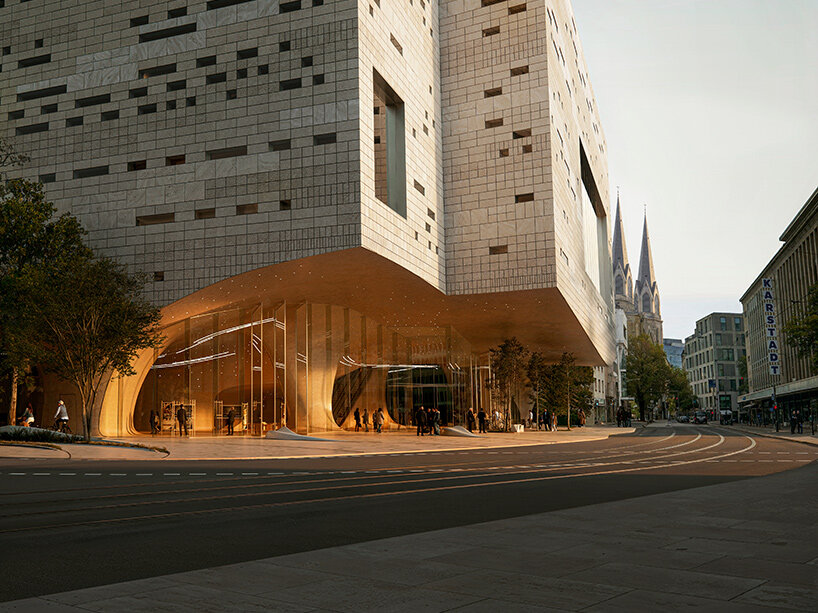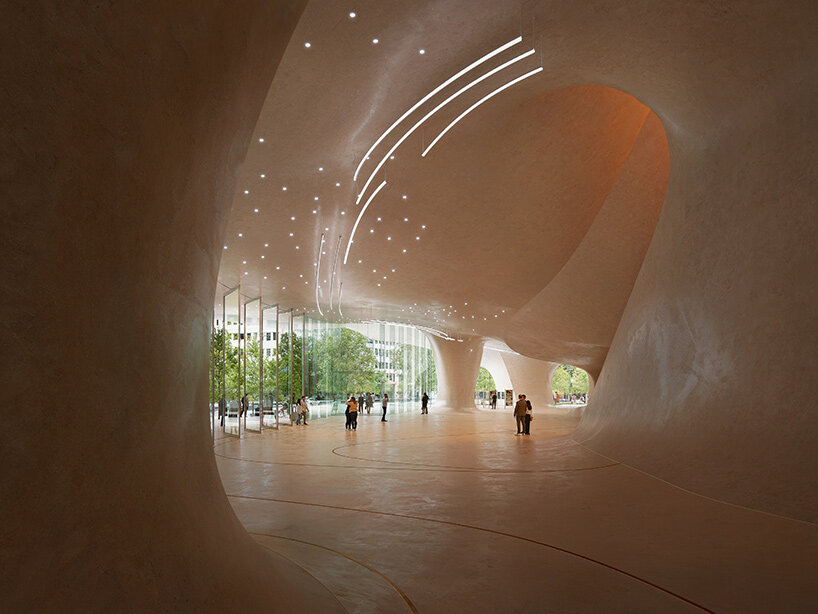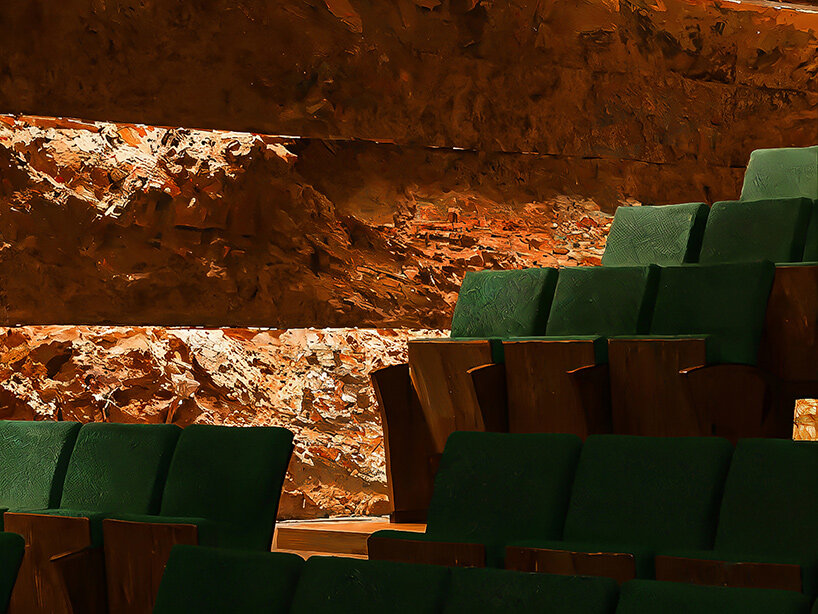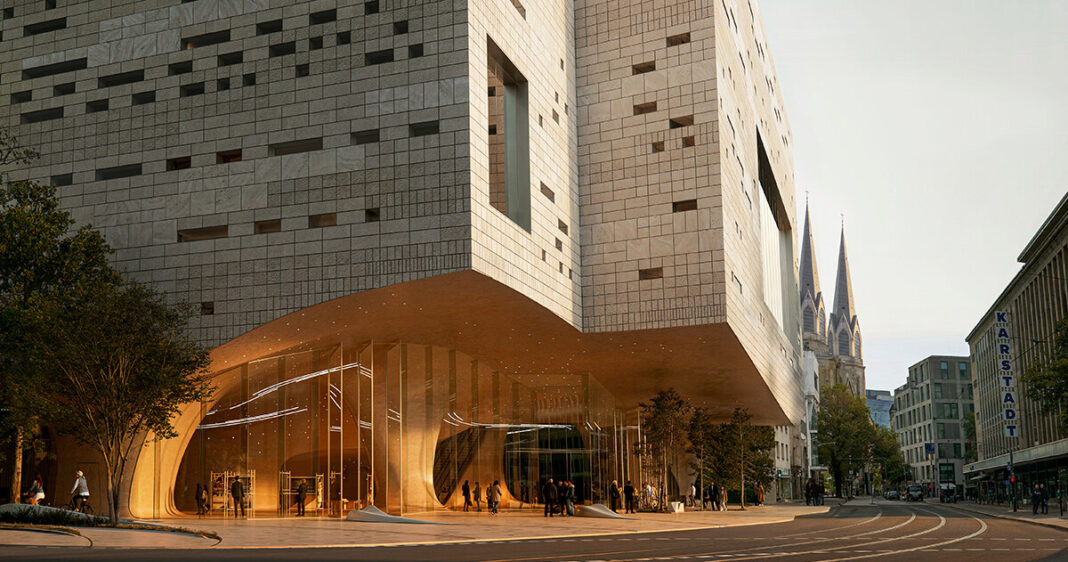an opera house for düsseldorf shaped by the river
This competition-winning opera house has been designed by Snøhetta as the future home of the Oper am Rhein at the center of Düsseldorf. The building is organized into three trapezium-shaped volumes placed on a compact urban plot, creating varied passages at grade and allowing daylight to reach deep into the interior. The roofs tilt in opposing directions, adjusting to the scale of neighboring structures while lifting upward to frame key views across the German city.
Across the ground floor, the architects draw from the Rhine’s long geological influence on the region. The base of the building reads as an eroded cavern carved through time, an open and continuous space that welcomes movement from every side. This porous level becomes a public arena for Düsseldorf, where entrances, gathering areas, and glimpses of rehearsal activity contribute to a sense of shared cultural territory.
‘This forum, filling the entire ground floor, will become a large, open, and accessible space in the heart of the city,‘ says Snøhetta founding partner Kjetil Trædal Thorsen.
the new opera is a densification within a triangular block bound by three streets | illustrations © Mir/Snøhetta
snøhetta composes a massing of three sloping volumes
The Düsseldorf opera house is designed by the team at Snøhetta as a constellation of rooms that guides visitors inward from the sidewalk and toward performance spaces within. The openness of the ground plane establishes a gradual threshold between the city and the world of the opera house. Visitors are encouraged to enter this public area even when no performance is underway.
The tripartite massing symbolizes the union of three institutions — the Deutsche Oper am Rhein, the Clara Schumann Music School, and the Music Library — brought together within one architectural frame.
The positioning of the building’s three volumes shapes pockets of space at the ground level that double as informal stages or quiet resting points. Meanwhile, sloping roofs accentuate these relationships and create terraces recessed into the upper levels.

the public ground floor opens out through generous glazing in all facades
the architecture draws from the region’s geology
The opera house’s facade uses a light natural stone cladding chosen by Snøhetta for its thermal performance and its ability to align with Düsseldorf’s muted palette. Stone modules in a variety of formats reduce waste and support a surface expression defined by subtle shifts in texture. Rough and finely ground finishes appear in horizontal bands, evoking the layers of sediment that shaped the region and linking the outer skin to the carved quality of the ground floor.
Two window systems support the building’s environmental and spatial aims. Larger openings frame the foyer, bar, and select rehearsal spaces, drawing attention to areas where public life is most visible. Smaller filtered openings provide consistent light and ventilation, helping regulate the interior without interrupting the facade’s calm rhythm.
Together, the rough stone, pixelated apertures, and stepped terraces create a profile that responds to its context but still maintain a monumental presence.

the sidewalk extends fluidly into a terraced, cave-like interior landscape
‘eroded’ interiors
Inside, Snøhetta’s theme of erosion continues through mineral surfaces with a muted flow of texture and tone. Circulation spaces maintain a sense of calm, guiding visitors toward the 1,300-seat main auditorium. Here, smoked oak paneling and red upholstery draw from the palette of Düsseldorf’s existing opera house, a decisions which establishes continuity as the institution transitions into its next chapter.
Above the stepped volumes, the roof forms a biosolar landscape composed of photovoltaics, green terraces, and integrated skylights. Plantings native to the Lower Rhine floodplains occupy bands between PV arrays and technical strips, creating a layered system that supports biodiversity and energy production.
For the competition jury, the design offered a convincing vision for a cultural building at the heart of the city. ‘The building, which is cleverly divided into three segments, skilfully reacts to its surroundings, opens up a variety of views of the city and shows a design of high sophistication,‘ says Heiner Farwick, architect and chairman of the jury.

the studio stage shows neutral, warm gray tones and dark green seating

interiors follow the logic of the facade and the theme of erosion

